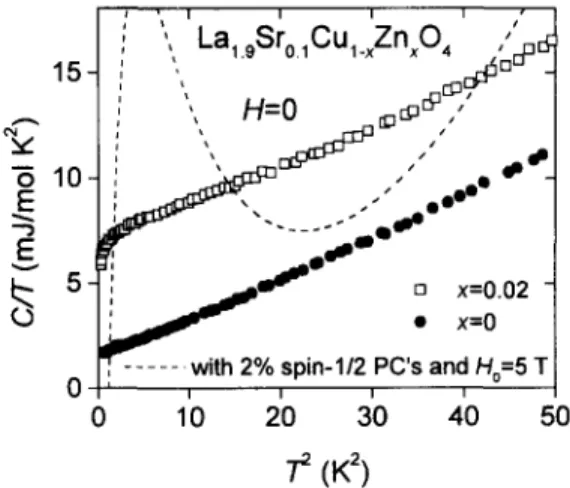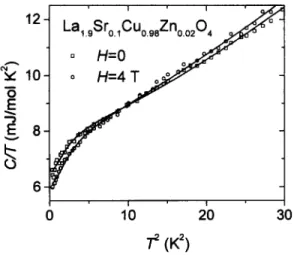PHYSICA
ELSEVIER Physica C 341-348 (2000) 673-674
www.elsevier.nl/Iocate/physc
A b s e n c e o f the p a r a m a g n e t i c c o n t r i b u t i o n in the l o w - t e m p e r a t u r e s p e c i f i c h e a t o f Lal.9Sro. l CuogsZno.0204
J.-Y. Lin a, C. F. Chang b, and H. D. Yang b
aInstitute of Physics, National Chiao Tung University, Hsinchu 300, Taiwan ROC. bDepartment of Physics, National Sun Yat-Sen University, Kaohsiung 804, Taiwan ROC.
The absence of the paramagnetic contribution in the low-temperature specific heat (C) of Zn-doped cuprates has attracted much attention recently. The phenomenon was usually explained as possible screening in the superconducting state. We have measured C of La19Sr04Cuo.98Zno.0204 which is not superconducting. Intriguingly, The upper limit of the magnetic contribution is found to be two orders of magnitude smaller than the expected value with no screening effect. This result puts the above explanation in a serious jeopardy.
Since the discovery of high-temperature superconductors, the effects of cation substitutions for Cu have been intensively studied. The Zn +2 ions, though nominally non-magnetic, could induce the local moments on the neighboring Cu sites when they are substituted in the CuO2 planes. These induced moments were observed by NMR and magnetic experiments [ 1 ]. However, recent specific heat (C) studies on Zn-doped YBa2Cu3Ox (YBCO) found an intriguing result that there was no apparent increase in the magnetic component of C associated with magnetic moments with increasing Zn doping [ 1 ]. Interestingly, partial screening of the moment was also found in susceptibility measurements [2]. In spite of no full understanding of this absence of the magnetic contribution in C, it is usually explained as possible Kondo screening in the superconducting state. To shed light on this mysterious missing magnetic contribution, the specific heat study on non-superconducting Zn-doped cuprates is of interest.
Polycrystalline samples of
Lal.9Sr0.1Cul.xZnxO4 with x=0 and 0.02 were carefully prepared similar to the samples described in [4]. The powder x-ray-diffraction patterns of both samples used in the experiments show a single T phase with no detection of impurity phases. The transition temperature Tc is 33 for x=0. The x=0.02 sample is not superconducting down to 2 K by either resistivity or magnetic measurements. C(T) was measured with a 3He thermal relaxation calorimeter using the heat-pulse technique. The 0921-4534/00/$ - see front matter 6) 2000 Elsevier Science B.M PII S0921-4534(00)00644-4
details of C(T) measurements can be found in [3]. C/T data of both samples are shown in Fig. 1. Both samples show no upturn in C/T at low temperatures. For cuprates, only samples with a very small paramagnetic center (PC) concentration n are free from the upturn in C/T down to such low temperatures. For example, with either spin-l/2 or spin-2 PC's, the analysis of C in magnetic fields H concludes that n is the order of 0.01% mol/mol for the x=0 sample [3,4]. Nevertheless, that there is no uptum in C/T of the x=0.02 sample is surprising
' I I I I /,
', La~ 9SrolCUt.xZnx04 ,'aa~ 15 " " " t~ 5a -
', H=0 t ~ ,,,'
. . - - " e o eee
5 _ ~ p ~ n x=0.02 "
• X=0
. . . with 2% spin-l/2 PC's and Ho=5 T
0
1'0
2'0
3'0
4'0
so
f f (K 2)
Figure 1. C/T vs. /~ of Lal.9Sr0.1CUl.xZnxO4. The dash line is the fit with 2% concentration of the paramagnetic centers for x=0.02 data.
674 ,L-J( Lin et al./Physica C 341-348 (2000) 673-674
since each substituted Zn atom in the CuO2 planes could at most induce four spin-l/2 local moments on the neighboring Cu sites. The dip in
C/T
of the x=0.02 sample is likely due to depression of quasiparticle density of states rather than due to the magnetic origin [5]. However, in order to estimate the upper limit of n of PC's, we have measured C of the x=0.02 samples at H=0 and 4 T as shown in Fig. 2. Assuming that there are spin-l/2 PC's, and that the dip and its H dependence are due to the Schottky anomaly, the data are fit toC(T~H)=~(H)T+]~ 3+OeTS+ nCschott~(T,H+Ho) (1)
,where ?(H)T is the electronic contribution,/~T3+O'T 5 are the phonon contribution, the last term is the Schottky anomaly, and H0 is the effective field in the sample. In order to describe the data in Fig. 2, the fits lead to n=0.06% and 0.13%, and/-/0---4.9 and 2.1 T for H=0 and 4 T, respectively. First of all, though the value of H0 is not particularly large, it has never been observed in samples with the same order of n. Therefore, the dip is unlikely to be caused by the Schottky anomaly. Even if it is, n is too small compared to the concentration of Zn. To demonstrate what 2% of PC's (a conservative value) can do to C, the zero field data of x=0.02 are fit with n=2% and/-/0--5 T. As shown by the dash line in Fig. 1, the fit is catastrophic and leads to an unrealistic negative y. As for the alternative that
O E . - j
E
12-
10-
. .0
' I ' I ' ~La~ 9Sro ~CUo 98Zno 0204
[] H = 0 o _ J
lb
2'0
3o7 = (K 2)
Figure 2.
C(T, H)
of the x=0.02 sample. The solid lines are the results of the fits by equation (1). The fits lead to n=0.06 and 0.13 % for H=0 and 4 T.four spin-l/2 local moments on the neighboring Cu sites could form a composite spin-2 PC's, the same analysis would lead to n=0.05 and 0.08% for H=0 and 4 T, respectively, with about the same H0 as mentioned above. We have also measured
C(T,H)
of a superconducting x=0.01 sample with Tc=14 K, and applied the same analysis to
C(T, H)
of this sample. The upper limit of n is found to be between 0.02% and 0.05 %. Thus, the absence of the magnetic contribution happens in both the superconducting and non-superconducting samples in a similar way. Table I summarizes the results presented above.In conclusion, we have shown that the magnetic moments are also overwhelmingly
screened in C measurements in
non-superconducting
Lal 9Sr0.1CuogsZno0204. Theseresults call for mechanisms other than screening in the superconducting state to explain the absence of the magnetic contribution in C for Zn-doped cuprates.
This work was supported by National Science Council of Taiwan ROC under the project Nos. NSC 89-2112-M-I 10-008 and 89-2112-M-009-007.
REFERENCE
[1] A. V. Mahajan, H. Alloul, G. Collin, and J. F. Marucco, Phys. Rev. Lett. 72 (1994) 3100. [2] D. L. Sisson, S. G. Doettinger, A. Kapitulnik, R.
Liang, D. A. Bonn, and W. N. Hardy, Phys. Rev. B 61, 3604 (2000).
[3] P. Mendel, J. Bobroff, G. Collin, H. Alloul, M. Gabay, J. F. Marcco, N. Blanchard, and B. Grenier, Europhys. Lett. 46 (1999) 678.
[4] S. J. Chen, C. F. Chang, H. L. Tsay, H. D. Yang, and J.-Y. Lin, Phys. Rev. B 58 (1998) R14 753. [5]C. F. Chang, J.-Y. Lin, and H. D. Yang,
cond-mat/0003022.
I
H=0
H=4 T
x=0.01 n=0.02% n--0.05%
x=0.02 n=0.06% n---0.13%
Table I. Estimates of the paramagnetic center concentration n from equation (1) for LaL 9Sro.1CUl.xZnx04.

